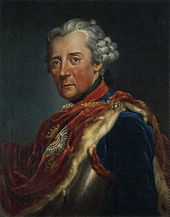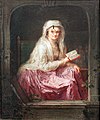Anna Dorothea Therbusch

Anna Dorothea Therbusch , nee Anna Dorothea Lisiewska (* 23. July 1721 in Berlin ; † 9. November 1782 ibid) was a German rococo - painter .
Life
Early painting career
Anna Dorothea Therbusch was the daughter of Georg Lisiewski , a Pole who worked at the court of the Prussian King Friedrich Wilhelm I and had started a family in Berlin. Since women were denied artistic training at the art academies , she, like her sister Anna Rosina de Gasc (1713–1783), received her training in portrait painting from her father, with whom her brother Christoph Lisiewsky (1725–1794) also received his first Got painting lessons. The work of the court painter Antoine Pesne can also be seen in the work of Anna Dorothea and her older sister Anna Rosina, who continued their self-taught training .
In 1742 Anna Dorothea Lisiewski married the Berlin innkeeper and hotelier of the "White Dove" from Heiliggeiststrasse Ernst Friedrich Therbusch (1711–1773). The couple had five children, four of whom survived. During these years of family duties of a middle-class life, her artistic activities were limited, so that she could paint and refine her skills secretly and often only at night.
In 1761, Duke Carl Eugen von Württemberg summoned Therbusch to Stuttgart. There she painted 18 over- portals for the mirror gallery of the New Palace within a very short time and in 1762 became an honorary member of the Académie des Arts . In the same year, her work fell victim to a castle fire. In 1764, Elector Karl Theodor von der Pfalz appointed Therbusch court painter in Mannheim . Her two portraits of the Elector are in the Reiss-Engelhorn-Museum Mannheim and the old Pinakothek in Munich . In terms of art history, they are considered evidence of the change from the official status portrait to an emphasis on the private and the greatness of an enlightened ruler .
Late artist years
In 1765 Therbusch finally went to Paris. The Académie Royale initially rejected her work because it was found too good to be from a woman. Denis Diderot mentions her works, among others. his portrait and its creation in the Correspondance litteraire of 1767 edited by Friedrich Melchior Grimm and himself. She is one of the people involved in his story Mystification . On February 28, 1767 Therbusch was accepted into the Académie Royale with the genre scene Young Man, holding a glass in his right hand, lit by a candle . She was the only woman to exhibit her paintings in the Paris Salon of 1767. On the painting by Gabriel Saint-Aubin , you can see her reception piece on the left in the lower row. Although Anna Dorothea Therbusch was economically unsuccessful in France, the years in Paris were her most successful artistically.
On December 6, 1768, Therbusch was the first woman to be admitted to the Academy of Fine Arts Vienna with her portrait of the landscape painter Jakob Philipp Hackert . Therbusch returned to Berlin in early 1769 via Brussels, The Hague and Amsterdam, where she completed her artistic training by studying the Braamcamps art collection and portraying the art collector Gerrit Braamcamp (1699–1771). Her painting technique of the faces, which she builds up with numerous thin glazes in order to achieve a natural incarnate , suggests a thorough study by Rubens .
After her return to Berlin in 1769 and an absence of almost ten years, Anna Dorothea Therbusch was the first painter in Berlin and Prussia to achieve high social esteem and professional recognition late at the age of fifty. After the death of her husband in 1772, as a widow, she and her brother shared a studio in the street Unter den Linden from 1773 . She provided the court of Frederick II with some historical pictures of mythological content for Sanssouci Palace and in 1775 portrayed the 63-year-old king. The mockingly commented:
"In order not to dishonor her brush, she has again adorned my contorted face with the grace of youth."
Empress Catherine II of Russia - also ruler of enlightened absolutism - commissioned her to paint the entire Prussian royal family in life-size full-body portraits (today in the Hermitage (Saint Petersburg) ).
Anna Dorothea Therbusch died at the age of 61 in Berlin and was buried there in the churchyard of the Dorotheenstädtische Church . The ornate epitaph was attached to the exterior of the new Dorotheenstadt Church after the baroque church was demolished in the mid-19th century . It was salvaged before the church ruins were blown up in 1965. Therbusch's grave has been in the Dorotheenstädtisch-Friedrichswerder cemetery since the churchyard was closed .
Diderot's relationship with the artist inspired the Franco-Belgian author and film director Éric-Emmanuel Schmitt to write the play Der Freigeist ( Le Libertin ) in 1997 , which was filmed in 2000.
factories
Anna Dorothea Therbusch created around 200 paintings. You are among others. in the New Chambers , in the New Palace and in the Sanssouci Palace in Potsdam, in the Berlin Gemäldegalerie , in the State Museum Schwerin , in the Mannheim Reiss-Engelhorn-Museums and in the Düsseldorf Palace Benrath . The whereabouts of many of her paintings are unknown.
Peter Anton von Verschaffelt , 1766
Jupiter and Antiope , 1775
Portrait of Henriette Herz , 1778
Self-portrait 1773 Herzog Anton Ulrich-Museum Braunschweig
Self-portrait, 1782, Germanisches Nationalmuseum Nürnberg
Catalog raisonnés
- Leopold Reidemeister: Anna Dorothea Therbusch, her life and work , Phil. Diss. Berlin 1924 (mach.)
- Gerd Bartoschek (Ed.): Anna Dorothea Therbusch, exhibition on the occasion of her 250th birthday , Potsdam 1971
- Ekhart Berckenhagen: Anna Dorothea Therbusch , in: Journal of the German Association for Art Studies , Vol. 41, 1987
- Katherina Küster: Anna Dorothea Therbusch , Diss. Heidelberg 2007
literature
- Friedrich Ludwig Joseph Fischbach : Historical political, geographical, statistical and military contributions , Volume 3, Part 2, p. 569, digitized
Scientific literature
- Sandrine Andrews: Femmes peintres . Larousse, 2021, ISBN 978-2-03-600293-7 , pp. 10-11
- Wilhelm Lütkemann: German Churches, Vol. 1: The Protestant Churches in Berlin (Old City), Berlin (publisher for popular literature), 1926, pp. 109–111
- Frances Borzello: How women see themselves. Self-portraits from five centuries , Karl Blessing Verlag, Munich 1998
- Helmut Börsch-Supan : Lisiewska, Anna Dorothea. In: New German Biography (NDB). Volume 14, Duncker & Humblot, Berlin 1985, ISBN 3-428-00195-8 , pp. 684 f. ( Digitized version ).
- Bärbel Kovalevski (ed.): Between ideal and reality, artists of the Goethe era between 1750 and 1850 , exhibition catalog, Hatje Cantz Verlag, Gotha, Konstanz 1999, ISBN 3-7757-0806-5
- Katharina Küster, Beatrice Scherzer, Andrea Fix: The unobstructed view. Anna Dorothea Therbusch and Ludovike Simanowiz. Two portrait painters of the 18th century , catalog for the exhibition of the Ludwigsburg Municipal Museum, Kunstverein Ludwigsburg, Villa Franck, 2002/2003, Kehrer Verlag Heidelberg 2002, ISBN 3-933257-85-9
- Katharina Küster: Anna Dorothea Therbusch, a painter of the Enlightenment. Life and work . Dissertation, Heidelberg 2008
- Gottfried Sello : Painters from five centuries, Ellert and Richter, Hamburg 1988, ISBN 3-89234-077-3
Fiction
- Cornelia Naumann: The portrait painter. The story of Anna Dorothea Therbusch . Meßkirch (Gmeiner) 2014, ISBN 978-3-8392-1498-5
Web links
- Literature by and about Anna Dorothea Therbusch in the catalog of the German National Library
- Works by Anna Dorothea Therbusch at Zeno.org
- Self-portrait (1761) ; Edited by the Central Office for Teaching Media (ZUM) in the Internet eV
- Works by Anna Dorothea Therbusch in the Gemäldegalerie Berlin, the Württembergisches Landesmuseum Stuttgart, GNM Nuremberg, Palaces Sanssouci and Rheinsberg (SPSG), Gleimhaus Halberstadt and others.
Individual evidence
- ↑ Self-portrait of Anna Dorothea Therbusch . Information on the picture at SMB-digital (online database of collections).
- ^ Helmut Börsch-Supan: Lisiewska, Anna Dorothea. In: New German Biography (NDB). Volume 14, Duncker & Humblot, Berlin 1985, ISBN 3-428-00195-8 , pp. 684 f. ( Digitized version ).
- ↑ Frauke Mankartz: The Friedrich brand: The Prussian King in a contemporary image. In: Foundation Prussian Palaces and Gardens Berlin-Brandenburg (Ed.): Friederisiko. Frederick the Great. The exhibition . Hirmer, Munich 2012, p. 209.
- ↑ West European Pastels of the 16th - 19th Centuries in the Hermitage ( Memento from August 1, 2012 in the web archive archive.today )
- ↑ On the epitaph (with illustration) see Martin Ernerth, Jörg Kuhn (ed.): Der Dorotheenstädtische Friedhof. Prominent history in the center of Berlin . VBB, Berlin 2019, ISBN 978-3-947215-49-2 , pp. 32–33.
- ↑ see caption on Wikimedia Commons
- ^ Entry in the state bibliography of Baden-Württemberg
| personal data | |
|---|---|
| SURNAME | Therbusch, Anna Dorothea |
| ALTERNATIVE NAMES | Lisiewska-Therbusch, Anna; Therbusch, Anna; Lisiewska, Anna Dorothea |
| BRIEF DESCRIPTION | German Rococo painter |
| BIRTH DATE | July 23, 1721 |
| PLACE OF BIRTH | Berlin |
| DATE OF DEATH | November 9, 1782 |
| Place of death | Berlin |








